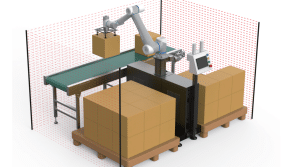In part 1 of our Return on Investment article, we looked at using two ways to justify an automation investment. We covered the Labour Cost Reduction and the Micro Level View of Capacity Release for calculating ROI. In this article, we will find out an easier way to calculate and justify automation ROI and how to handle some unique automation applications.
Previously we saw that Capacity release was a more realistic way to justify automation investment. However, it is difficult to determine which tasks a worker might be moved over to in the future after some process automation is implemented. The solution is to look at the company averages.
Macro Level view for Capacity Release
With the Micro Level view, we were looking at the specific tasks being done before and after the automation implementation. However, with the Macro Level View, we use the averages of the overall company throughput to estimate the ROI.
Example 3
For this example, we are now looking at the total company performance. We will assume we have a company with 100 direct employees, total company revenue of £10 million and 1 million products manufactured.
| Inputs | |
|---|---|
| Total Company Revenue [per year] | £10,000,000 |
| Total Products Produced [per year] | 100,000 |
| Head Count | 100 |
We can then calculate the average selling price (£100), the average number of products produced by each employee each year (1,000) and the annual revenue produced by each employee (£100,000).
| Calculation | |
|---|---|
| Average Selling price [per product] | £100 (£10,000,000 / 100,000 products) |
| Annual products produced [per employee] | 1,000 (100,000 products / 100 employees) |
| Annual Revenue [per employee] | £100,000 |
If we keep our required margin at 50%, we can determine the average annual profit generated by each employee is £50,000. Looking at our £100,000 project, our payback would be 2 years.
| Results | |
|---|---|
| Avg Annual Profit generated [per employee] | £50,000 (50% margin) |
| Payback [years] | 2 (£100,000/£50,000) |
This Macro Level view example shows us that if we repurposed an
Average employee → making an average product → sold at the average price → at the average margin
The payback would be in two years.
Takeaways of Macro Level View – Capacity Release
The advantage of a Macro Level Capacity Release ROI calculation is that, like the Micro level version, it is a true payback period, and the numbers tend to be more generous than the labour reduction for justifying investment. It has the added advantage that it is easy to do and though it might not take into account all of the details, when you are talking about payback in years and not months, these details are less critical.
The negatives of this method are still that the calculation assumes we can convert the released capacity to revenue.
Quality improvements
Sometimes the drive to automate is for consistency improvements, defect reduction, or HSE concerns. These types of metrics require a slightly different approach to ROI calculation. The obvious place to start is a quantification of the time and money spent
- identifying and rectifying problems
- scrap from poor-quality components or assemblies
- Lost time due to accidents and HSE incidents
However, there is another cost to consider: Loss of trust in the brand and company.
Loss of Trust
A crucial secondary cost to consider is the loss in brand trust and the implication for sales or revenue of the depreciated brand perception. This can be difficult to quantify, but data suggests up to 65% of consumers will swap their brand loyalty if a customer experience doesn’t meet their expectations. (Link)
Another way to quantify loss of brand trust is to look at any data for previous marketing initiatives which resulted in positive changes in revenue and then invert the gains as possible losses.
Opportunity Cost
The final piece of this justification is to look at those quality investigation and rework activities with a mindset of “opportunity cost”. So, what does this mean?
If you pay someone to rework a component, we have now not only put more labour cost into that component, but we have also lost the “opportunity” to have that person make something else of more value to the company.
Let’s revisit example 2 from above where Product A had £1 of labour.
Example 4
| Example 2 Inputs for Product A | |
|---|---|
| Project Cost | £100,000 |
| Labour cost of process [per piece] | £1 |
| Material Cost [per piece] | £1 |
| Qty of pieces [per year] | 35,000 |
In this example, we have a component defect which could add a rework cost of £1.
| Product A | Inputs |
|---|---|
| Rework cost [per piece] | £1 |
The options for the company are:
- Scrap the defective parts and remake the new parts. This will result in one (1) made part, total labour is £2, and total material is £2. Final total cost is £4.
- Rework the defective parts. This will result in one (1) made part with a total labour of £2, total material is £1. Final total cost is £3.
| Product A | Calculations |
|---|---|
| Option 1 – scrapped parts: Final part cost | £4 (2 x £1 labour cost + 2 x £1 material) |
| Option 2 – Reworked parts: Final part cost | £3 (1 x £1 labour cost + £1 rework + 1 x £1 material) |
Our Sale price for this product hasn’t changed, it is still £4. So, if we review the margin, we see for Option 1 our margin is £0 (0%) and for Option 2 our margin is £1 (25%).
Depending on the frequency of this failure, an ROI could be created to justify this investment to automate this process, improve the quality, and save the company money.
However, the lost Opportunity Cost for this duplicate labour should also be considered. You could have put that £1 of labour into Product B, the premium product from Example 2. Because of this required rework, we have “lost the opportunity” to make the higher profit from the premium product.
| Product B | Inputs |
|---|---|
| Total Labour cost [per piece] | £1 |
| Total cost [per piece] | £10 £1 (Labour cost) + £9 (material cost) |
| Selling price [per piece] | £20 |
| Profit [per piece] | £10 (£20 x 50%) |
So, we haven’t just cost the business £1 or £2, we have actually cost the business the rework cost plus the £10 in Opportunity Cost.
| Product B | Results |
|---|---|
| Lost Profit opportunity [per year] | £10 |
Takeaways of a Quality/HSE automation implementation ROI
Some automation projects will have drivers that supersede any capital return calculation, these types of projects could include:
- shortcomings in quality
- Safety concerns
- Regulatory requirements
However, even with these types of higher priority requirements some details of “break-even” will often be expected. These calculations become easier if you keep in mind things like:
- Loss of brand trust
- Lost work time due to injury
- Lost work time due to root cause investigation and failure identification
- Direct rework cost
- Opportunity cost
Best way to calculate ROI for my investment?
While there is no one-size-fits-all for creating an ROI justification for an automation project, we would recommend not using Labour Cost reduction, unless you are actually going to be cutting those costs from the business. Most of the time we would recommend looking at how your resources are going to be redeployed and what benefits that brings to the business in terms of capacity and throughput.
| Pros | Cons | |
|---|---|---|
| Labour Reduction | – Easy to understand – Easy to evaluate against a company’s investment policy | – Not an actual savings for business – If it is a savings, it means workforce was cut Usually overly conservative |
| Micro View Capacity release | – True payback period – Justification tends to be more generous than labour reduction calculations | – Hard to calculate what a “hypothetical” person will be doing after implementation. – Assumes released production capacity can be converted into revenue |
| Macro View Capacity Release | – True payback period Justification tends to be more generous than labour reduction calculations – Use of averages dampens any effect process outliers – Easy to do and understand | -Assumes released production capacity can be converted into revenue – If the process being automated or the process workers are moved to are outliers, calculations might be skewed |
| Quality improvements | – Usually are not justified solely by ROI, higher priorities govern – Can use loss of brand trust, and Opportunity Cost to bolster justification | – Calculation may be hard to do on direct rework and lost time alone |
Next steps for your automation implementation
If you have an automation project in mind and are struggling to justify the costs, hopefully, this article has given you new ways to think about automation ROI. It is crucial that the UK continues to accelerate our investment in automation and reaps the benefits of increased production capacity, improved product quality, reduced waste, and improved HSE. Drop us a line if you need help constructing a business case or need some examples for calculating ROI for your specific project.





